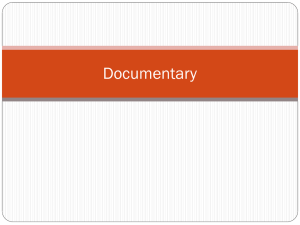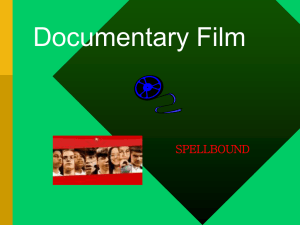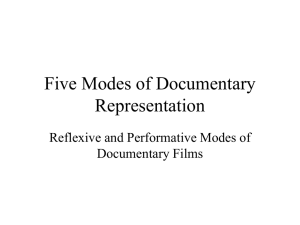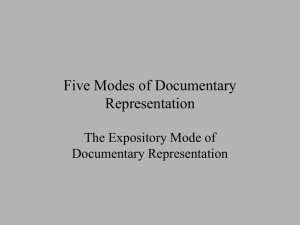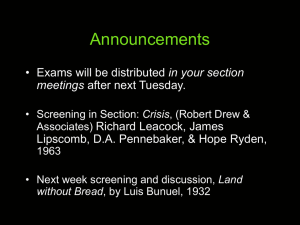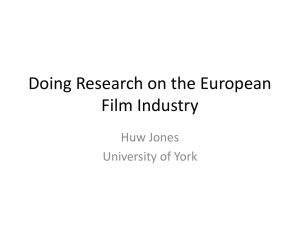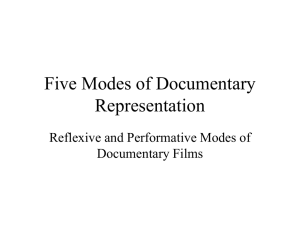The documentary - Barbara Reimer
advertisement
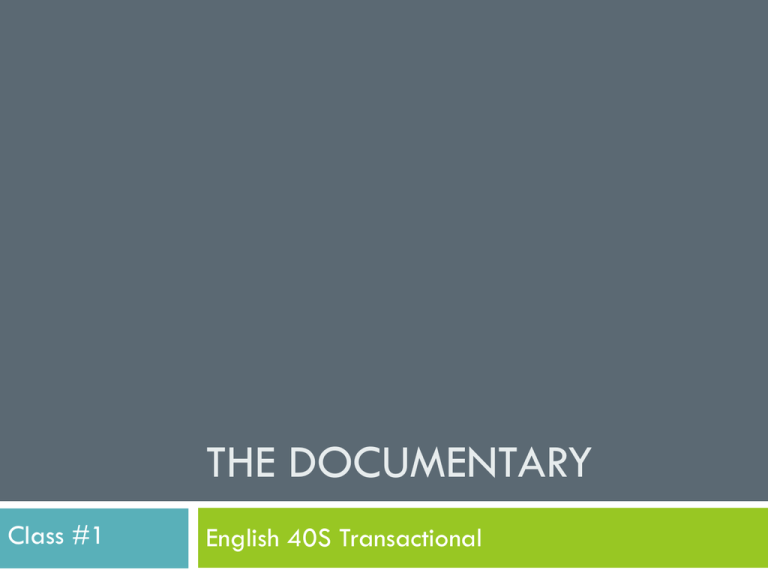
THE DOCUMENTARY Class #1 English 40S Transactional The Documentary I don't know what truth is. Truth is something unattainable. We can't think we're creating truth with a camera. But what we can do, is reveal something to viewers that allows them to discover their own truth. —Michel Brault Class #1 – Objectives What is a documentary? What are the elements (different parts) of documentaries? What are the different types of documentaries? Discussion What is a documentary? (provide a definition) What are some documentaries you have seen? (not just the ones you have heard of) What are the qualities or parts of a documentary? In other words, what makes a documentary a documentary? What are the different types of documentaries? What is the purpose of a documentary? Why do people make them? What is Documentary? Usually come with a label i.e. They say that they are a documentary Expectation that the people/events/places were or are real Factual information about the world “Film Art: An Introduction” – pp. 350-351 Types of Documentaries Expository Poetic Observational Participatory Reflexive Performative Compilation Direct Cinema (Cinema-Verite) Categorical Rhetorical DOCUMENTARY FILM HISTORY Class #2 English 40S Transactional Class #2 Objectives Where did the documentary come from? How has the documentary evolved over the years? Documentary Film History Recall: The documentary is based on the idea of ‘documenting’ reality in one way or another This genre is constantly changing http://documentaryarchive.com/documentary_history.html Photography & Cinema How exactly is a film made? Chronological History Pre-1900 The term documentary was used to refer to any works of non-fiction film Travelogues Instructional films The earliest ‘moving pictures’ were considered documentaries Single-shot moments captured on film Called ‘actuality’ films http://documentaryarchive.com/documentary_history.html Photography & Cinema The invention of photography in 1826 launched a series of discoveries that made cinema possible. Early photographs – lengthy exposures 1870s – faster exposures, but only on glass plates 1878 – Eadweard Muybridge (American photographer) Made a series of photographs of a running horse by using a series of cameras “Film Art, An Introduction” p. 463 Eadweard Muybridge 'Muybridge and Athlete' Taken as part of a motion sequence at Pennsylvania University. © Kingston Museum and Heritage Service, 2010 http://www.eadweardmuybridge.co.uk/muybridge_image_and_context/introducing_muybridge/ Eadweard Muybridge 'Horse. (Occident) trot with sulky' An early image with painted areas to improve clarity. © Kingston Museum and Heritage Service, 2010 http://www.eadweardmuybridge.co.uk/muybridge_image_and_context/animal_in_motion/ Meet the Art – Eadweard Muybridge http://www.youtube.com/watch?v=FYKZif9ooxs Photography & Cinema 1882 Etienne-Jules Marey Not a photographer, but a physiologist (interested in the movement of the human body) invented a camera that recorded 12 separate images on the edge of a revolving disc of film on glass 1888 – built first camera to use flexible strip of film on paper http://documentaryarchive.com/documentary_history.html Etienne-Jules Marey http://www.exeter.ac.uk/bdc/young_bdc/movingpics/movingpics6.htm# Edison vs. Lumière 1893 – “Edison Manufacturing Company in America” developed a camera that made short 35mm films Kinetoscope – could show films to individual viewers Thought that films were not going to last, so they did not develop a way to show these films to more than one viewer http://documentaryarchive.com/documentary_history.html The Kinetoscope http://www.malagent.com/archives/1408/kinetoscope The Kinetoscope http://reflexions.ulg.ac.be/cms/c_24658/kinetoscope Kinetoscope Films http://www.youtube.com/watch?v=WmZ4VPmhAk w Edison vs. Lumière Invented their own camera independently Exposed a short roll of 35mm film and also served as a projector December 28, 1895 – presented their film on a screen at the Grand Café in Paris Edison followed their lead and abandoned the Kinetoscope “Film Art, An Introduction” Lumière Brothers Arrival of a Train at La Ciotat http://www.youtube.com/watch?v=hlb3XKjnZkE L’Arroseur arrose http://www.youtube.com/watch?v=UlbiNuT7EDI Méliès, Magic, and Fictional Narrative Georges Méliès Stage magician by trade 1896 – built his own camera based on a projector that he had bought First films were of everyday life Built elaborate settings to create fantasy worlds 1902 – Trip to the moon 2011 – Hugo (trailer) http://www.youtube.com/watch?v=oYRemE9Oeso&feature=watc h-now-button&wide=1 http://www.youtube.com/watch?v=hR-kP-olcpM “Film Art, An Introduction” 1900-1920 Travelogue films ‘scenics’ In the Land of the Head Hunters (1914) Embraced primitivism and exoticism http://www.youtube.com/watch?v=ithkKCpBYlA South (1919) Documentary about the failed Imperial Trans-Antarctic Expedition led by Ernest Shackleton in 1914 “Film Art, An Introduction” 1920s Romanticism Documentary film embraced romanticism Robert J. Flaherty’s Nanook of the North (1922) http://www.youtube.com/watch?v=kaDVovGjNOc&feature =watch-now-button&wide=1 Heavily staged Harpoons instead of guns Building a roofless igloo http://documentaryarchive.com/documentary_history.html 1920s The city symphony Tend to feature people as products of their environment Berlin, Symphony of a City http://www.youtube.com/watch?v=OYKu5zegpfc&feature=watc h-now-button&wide=1 Rien que les Heures Man with the Movie Camera http://www.youtube.com/watch?v=00ZciIC4JPw http://documentaryarchive.com/documentary_history.html 1920s Newsreel tradition Sometimes staged Usually re-enactments of events that had already happened Battle footage – cameramen would arrive after a major battle and re-enact scenes to film them http://documentaryarchive.com/documentary_history.html 1920s “Cinema truth” Dziga Vertov Believed the camera could render reality more accurately than the human eye Varied lenses Shot editing Time-lapse Slow motion Stop motion Fast motion http://documentaryarchive.com/documentary_history.html 1930s-1940s: wartime propaganda Leni Riefenstahl’s “Triumph of the Will” Frank Capra’s “Why We Fight” (US) http://www.youtube.com/watch?v=GHs2coAzLJ8 http://www.youtube.com/watch?v=Mm3GsSWKyso&featur e=fvst Grierson, Film Board of Canada http://www.nfb.ca/film/grierson (documentary on Grierson – 57 minutes) Humphrey Jennings “ Fires were Started” and “A Diary for Timothy” (Britain) http://www.youtube.com/watch?v=0UuaJPGee20 http://documentaryarchive.com/documentary_history.html 1950s – 1970s “Cinema Truth” French “Cinema Verite” Contains little of the Vertovian special techniques Shooting on location Smaller crews Using smaller cameras – better able to follow ‘action’ as it happens Les Raquetteurs, Showman, Salesman, The Children Were Watching, Primary, Behind a Presidential Crisis, Grey Gardens http://documentaryarchive.com/documentary_history.html 1950s – 1970s “Direct Cinema” North American Take different viewpoints on their degree of involvement Important Directors who use this technique include: French Canadian Michel Brault, Pierre Perrault, Americans Richard Leacock, Frederick Wiseman, and Albert and David Maysles Non-involvement Direct involvment Provocation Following a person during a crisis with a moving camera to capture more personal reactions No sit-down interviews Usually an 80:1 shooting ratio http://documentaryarchive.com/documentary_history.html 1950s – 1970s Political weapons Used as a political weapon against neocolonialism and capatialism (Latin America, Quebec) La Hora de los hornos (The Hour of the Furnaces, 1968) http://documentaryarchive.com/documentary_history.html Modern Documentaries Becoming more successful in theatres Bowling for Columbine Super Size Me Fahrenheit 9/11 ($228 million, 3 million DVDs) March of the Penguins An Inconvenient Truth http://documentaryarchive.com/documentary_history.html Modern Documentaries Style has changed Stylized re-enactments (The Thin Blue Line) More interpretive control in the hands of the director (Roger and Me) Commercial success (can they really be called documentaries … ‘docu-ganda’) Funding still remains difficult http://documentaryarchive.com/documentary_history.html Other Documentary Forms Compilation films “The Fall of the Romanov Dynasty” (1927) by Esfir Schub “Point of Order” (1964) by Emile de Antonio “The Atomic Café” “The Last Cigarette” http://documentaryarchive.com/documentary_history.html FILM THEORY & TERMINOLOGY Class #3 English 40S Transactional Objectives Range of tonalities Speed of motion Perspective Framing Creative decisions in camera/filming techniques KWL K W L Cinematography “writing in movement” Depends on a large part to photography The Range of Tonalities Contrast The difference between the darkest and lightest areas of the frame Eyes are highly sensitive to differences of colour, shape, texture, and other aspects of a picture http://www.danheller.com/images/Europe/Ireland/Leinster/Dublin/Bw/img1.html Contrast Many factors are used to control contrast: Lighting Filters Choice of film Laboratory processing Post-production work Exposure Exposure regulates how much light passes through the camera lens. Sometimes you may want an unbalanced exposure Underexposure – shadowy Overexposure – bright Exposure can be affected by filters Be careful if you use i-Movie Changing Tonality after Filming Tonalities can be manipulated after filming Tinting Works on film that has been already developed Dark areas remain black and gray, while the lighter areas pick up the colour of the tint Toning Works on film during developing Darker areas are coloured, while lighter portions remain white or only faintly coloured Speed of Motion The speed of the motion presented onscreen depends on the relation between the rate at which the film was shot and the rate of projection. Calculated in frames per second 1920s – 24 frames per second (fps) Jerky Today movements – anywhere between 8 and 64 fps Speed of Motion Fast-motion Koyaanisquatsi by Godfrey Reggio http://www.youtube.com/watch?v=fY4L5npPdao Supernatural Hectic pace Grab attention Accelerate the pace Slow-motion Often functions to suggest that the action takes place in a dream or fantasy To show enormous power For emphasis Speed of Motion Time-lapse Sun set Flower sprouting Hundreds or thousands of frames per second http://vimeo.com/22439234 Perspective The short-focal-length (wide-angle) lens Less than 35mm gauge Takes in a relatively wide field of view Distorts the edges of the frame, budging them outward The middle-focal-length (medium) lens 50 mm Horizontal and vertical lines are rendered as straight and perpendicular The long-focal-length (telephoto) lens Take in a narrower angle of vision 100mm (+) often for sporting events Depth of Field Every lens has a specific depth of field – a range of distances within which objects can be photographed in sharp focus, given a certain exposure setting If you are outside of the depth of field – the image will be out of focus! Important to know the controls on the device in which you are using. Framing One of the most powerful cinematographic techniques Think back to the Lumiere film The Arrival of a Train at La Ciotat Station (1897) Oblique angle resulting in a dynamic composition Shows that camera position shapes the way we perceive the filmed event The act of framing has many implications The size and shape of the frame matter Framing creates a vantage point Framing can move in relation to what it films Aspect Ratio The ratio of the frame width to frame height is called the aspect ratio. An image that is twice as wide as it is high is said to be in a 2:1 ratio. Academy ratio = 1.37:1 (common until 1950s) Aspect ratio = 1.85:1 (North American ratio) Aspect ratio = 1.66:1 (European ratio) Aspect ratio = 2.2:1 (70mm widescreen) Camera Angle The frame positions us at some angle on the subject Straight-on High angle Low angle angle Camera Level Level – more or less parallel to the horizon Canted – if the framing is tipped to one side or the other Also called a “Dutch angle” Can create a disruptive feeling Camera Height Height is related to camera angle. but if the angle is kept straight, you crouching to take a shot will have a different composition than standing to take it. Camera Distance Extreme long shot Human figure is lost or tiny Long shot Figures are more prominent, but the background still dominates Medium Long Shot Knees up Medium Shot Waist up Camera Distance Medium close-up Chest up Close-up Just the head, hands, feet, or a small object Emphasizes the facial expression, the details of a gesture, or a significant object Extreme close-up Singles out a portion of the face or isolates and magnifies an object Mobile Framing Allows the filmmaker to change the camera angle, level, height, or distance during the shot. Aka camera movement Panning – moving from left to right or vice versa. Tilt – rotating up or down Tracking or Dolly shot Crane shot The camera itself does not move. Camera moves above ground level (elevator, plane) Zoom Mobile Framing Why? Can increase information about an image New information is revealed Greater value As a substitute for our movement Powerful cues Assignment Camera Shots and Film Composition Assignment See handout METHODS OF PERSUASION Class #4 English 40S Transactional Objectives Ethos, pathos and logos What are they? Constructing an effective argument using these three methods of persuasion Identify these methods in film clips How can they be used in documentaries? Explain how they can work together to form a strong argument Methods of Persuasion Ethos, Pathos, Logos Ancient Greek study of “Logic” Used all the time & everywhere! Television Print media Many advertisements use all three methods Also used in documentaries Logos Logic Facts Reason Rationality Almost an academic approach People need factual reasons why they should belive your argument Cite: Charts, data, graphs, etc. Ethos Credibility & Trust Quotes The power of authority on your side Not necessarily rationality Cite: Famous people, Dr’s, judges, etc Have some power because of their ‘status’ in society Pathos Pity/Emotion/Imagination If your argument can not appeal to logos or ethos, you can still use pathos as a means of winning your argument Appeal to senses Appeal to memory Appeal to a common experience More of a poetic way to get people on your side Cite the underdog, those who have it bad Let’s try out these methods Working in small groups, design the arguments that would be used in a tv commercial to sell knives. How would you appeal to logos? How would you appeal to pathos? How would you appeal to ethos? Identifying Ethos, Pathos & Logos in Print Media Using the computer, locate 2 news articles and print them. Identify characteristics of ethos, pathos, and logos in each one using the handout provided. You may jot down words, phrases, or whole sentences. Then answer the questions that follow in your handout. THE POWER OF PERSUASION Class #5 English 40S Transactional Objectives introduce and discuss methods of ethos, pathos, and logos in creating an effective argument identify methods of ethos, pathos, and logos in film clips explain how these three main styles of persuasion are used in documentary films explain how these three forms of persuasion can work together to create a strong point of view determine a director's intent and purpose for filming observe how persuasion is used in documentaries Parts of a Documentary Visual Track Audio Track Text Track RESEARCH Class #6 & #7 English 40S Transactional Objectives be familiar with researching techniques using the Winnipeg Public Library search engine understand what type of information is 'credible' be able to collect a variety of sources of information (not just websites) Be able to follow APA formatting guidelines English 40S - Transactional Formatting Guidelines (APA) Cover Page First page No page number Title (creative) – centre of page – size 20 font Your name – underneath title My Name (Barbara Reimer), Transactional English 40S, Date – all in lower right hand corner (single spaced) Body 1” margins Title – upper left corner Page # - upper right corner (cover page does not count as page 1) double line spacing Headings for each section – be creative!! Can be in bold – left hand side In-text citations (quotations, paraphrases) – just put page # in brackets (24). In-Text Citations Must include the author and date of the sources, either within the sentence or in parentheses. According to a 2002 essay by Patrick Marshall … According to a recent essay by Patrick Marshall (2002) … According to a recent essay (Marshall, 2002) … In-Text Citations Place the author’s last name and the date of the work in parentheses. If you site a specific part, give the page number. Gene therapy holds great promise for the future (Gormann, 2003, p. 48). References Title – References – at the top of the page – centre, bold APA formatting: Author’s last name, Initials. (year). Book Title. Location: Publisher. Integrating Quotations Never have a quotation standing alone as a complete sentence, or worse, as in incomplete sentence! If a quotation is not connected by one of your own sentences, it will seem disconnected from your thoughts and from the flow of your sentences. Short Quotations There are three ways to integrate short quotations: Introduce the quotation with a complete sentence and a colon. Use an introductory or explanatory phrase, but not a complete sentence, separated from the quotation with a comma. Use short quotations (only a few words) as part of your sentence. Complete sentence/colon In “The Most Dangerous Game,” Rainsford realizes that no one aboard the yacht realizes his situation, and that they will not rescue him: “The lights of the yacht became faint and ever-vanishing fireflies; then they were blotted out entirely by the night.” Phrase/comma According to Thoreau, “We do not ride on the railroad; it rides upon us.” Punctuating Quotations Periods and commas should be placed INSIDE the quotation marks. Colons and semicolons should stay OUTSIDE the quotation marks. Cite information using APA formatting (which we will discuss tomorrow). Do not change the grammar in the quotation. Punctuating Quotations Do not quote more than you need. Use [ ] to indicate changes to a quote (for example, adding in a word or changing the form of a word). Use ellipses (…) to indicate missing parts of a quotation Winnipeg Public Library http://support.epnet.com/training/flash_videos/intr o_to_ehost/intro_to_ehost.html PREPRODUCTION Class #8 English 40S Transactional Objectives be familiar with the purpose of a storyboard have experience using a storyboard for a short film or documentary be familiar with the purpose of a treatment create a treatment for a short film or documentary Video Proposal Form Type of video Topic Length Title (tentative) Content Summary (brief) Rationale: Purpose Audience Locations Actors Script Audio Graphics Other Treatment & Plot Explanation Begin your treatment with a short description of the project (this can be done in a few sentences). Then include a more in depth plot description (a few paragraphs). Include a description of all of the necessary materials you will need for each of the different scenes. include a listing of all of the necessary items for each of the characters (clothing, makeup, props, hair, etc). Plot Graph Climax Conflict Resolution Exposition What is a storyboard? A storyboard is a sketch of how to organize a story and of the shots you want to take for your film Example http://accad.osu.edu/womenandtech/Storyboard%20Resource/ Storyboard Template WINDOWS MOVIE MAKER Class #7 English 40S Transactional Objectives Learn to use Movie Maker Without wanting to throw your computer! HAVE FUN!! The Basics Importing your video clips Importing your audio Arranging your clips Modifying your clips Inserting transitions Modifying audio HAVE FUN!!!

